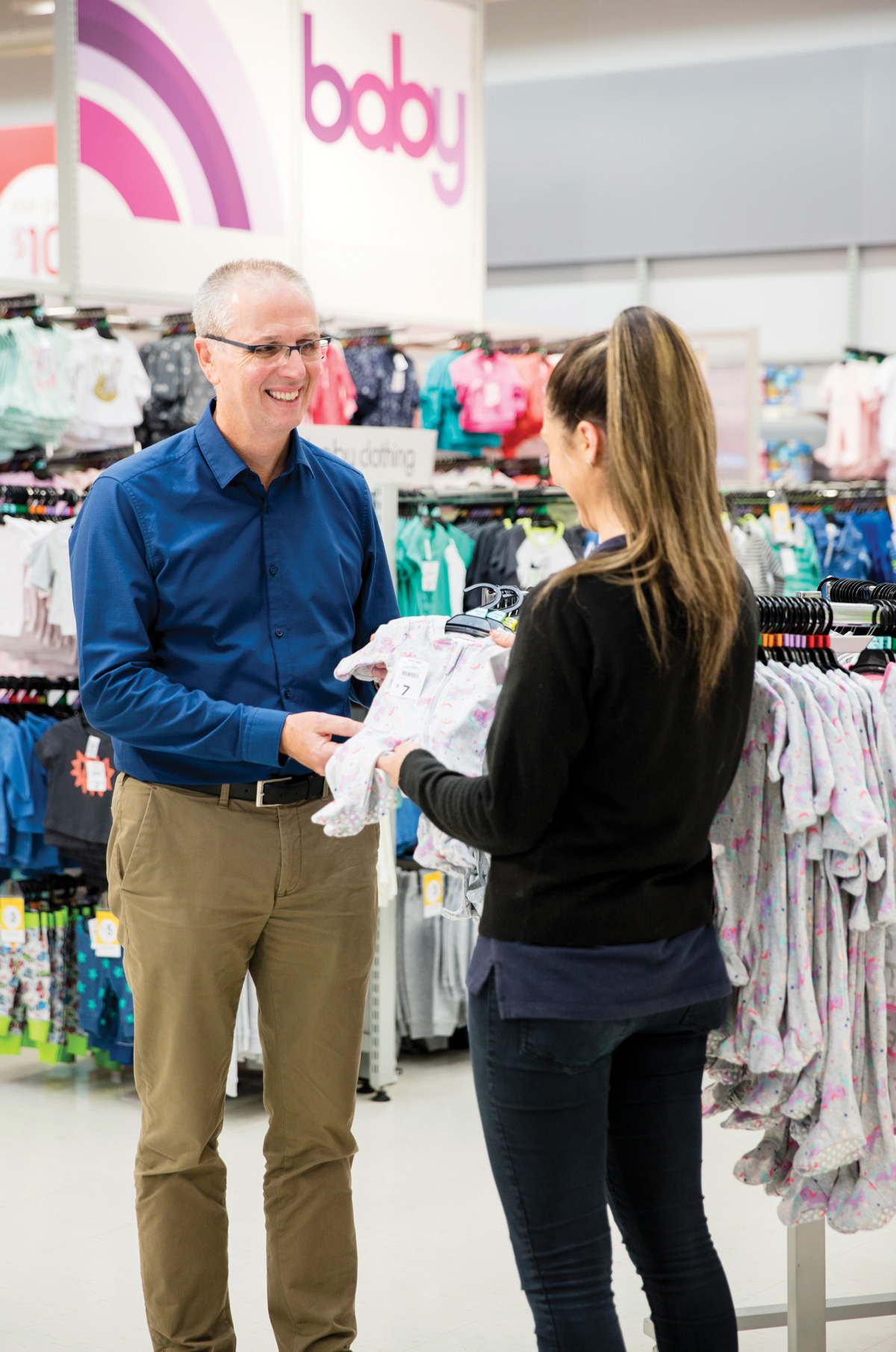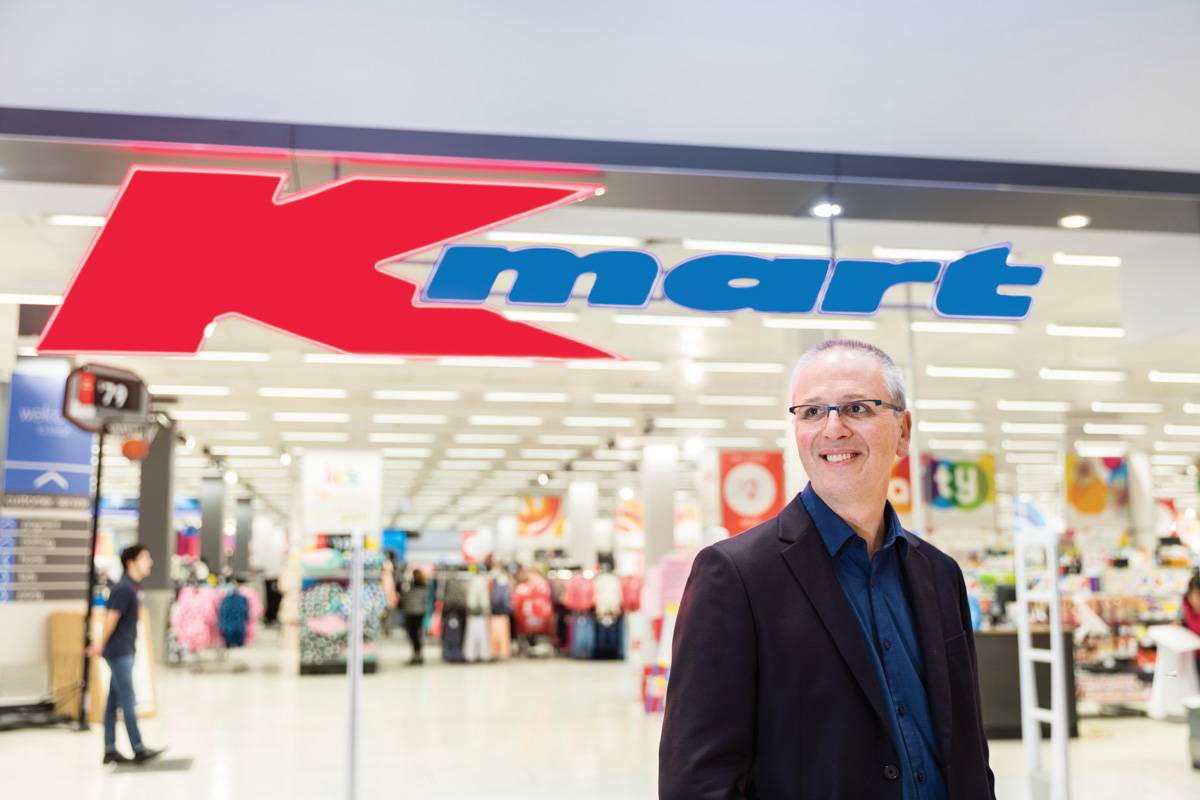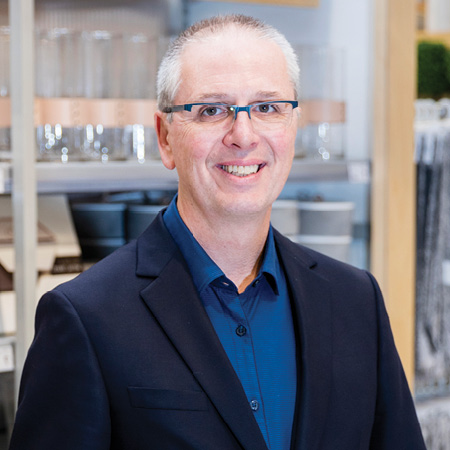In April 2016, Kmart Australia’s new Managing Director, Ian Bailey, donned a hard hat and stood in the bare 6,600-square-metre store development site in Port Macquarie, New South Wales. With the drone of excavators signalling to the public that construction on a local store had begun, passers by shouted from their cars, “We love Kmart!”, while locals and shopkeepers alike buzzed with excitement at the prospect of the store, due for completion mid-2017. The people of Port Macquarie had long dreamed of their own Kmart, and to see the enthusiasm of the community as the company made good on its promise demonstrated how well-loved the brand really was, causing a wave of pride to wash over Ian.
“We’ve been trying to get into Port Macquarie because we haven’t had a Kmart in that town for a long time, and now they’re so excited,” he says. “You have to love working for a company where you get that kind of feedback from customers.” Ian was first appointed Managing Director for the popular retailer in March 2016 following the creation of the Department Stores division under umbrella company, Wesfarmers, which developed as part of a new merger between Kmart and Target. Prior to this, Ian was Kmart’s Chief Operating Officer during which he was instrumental in the retailer’s turnaround initiative: establishing an ethical international sourcing model; repositioning the brand messaging through marketing and customer engagement; and working closely with the in-house merchandise team.

Third time’s the charm
While Ian was COO, Kmart reported a 12.6-per-cent increase in year-on-year revenue to $2.7 billion in the six months to 31 December 2015. Despite his success and enthusiasm in driving Kmart’s ongoing growth through periods of great change, retail was not Ian’s first choice of career — in fact, it wasn’t even his second. As a youngster growing up in the UK, Ian had always dreamed of a sporting career. “When I first left school, I tried to play tennis full time. My intent was to be a professional tennis player, but that didn’t quite work out,” he laughs. “I did that for a couple of years, between the ages of sixteen and eighteen, but then I decided to go to university to study a Bachelor of Science in civil engineering.”
For Ian it was a case of ‘the third time’s the charm’, with his next foray into finance leading him into the retail sector. Unsatisfied with his engineering degree, Ian pursued accounting studies, including completing an Advanced Management Program at Harvard Business School. “Once I got through accounting I did all sorts of roles, from consulting to sales to finance and everything in between. I got the chance to work in Australia in the mid 90s, and I really loved living here, so I went back to the UK after that role finished and applied for permanent residency. I stuck all my stuff in a container and came back out to Australia to work.”
[Putting families first] has been our mantra for the last eight years, and there’s absolutely no need for me to adjust that. However, if we just keep doing what we did last year, that’s never enough.
Ian’s first retail role came in 2002 when he was appointed the General Manager of Finance for Officeworks. “I had four years at Officeworks, which were fantastic — I really enjoyed it. After that, I moved across to Kmart, first as the General Manager of Finance, which then became CFO. I’ve been with Kmart now for about ten years,” he says.
The question was: how do we keep that going, and also improve what we have?
Seven years into his time with Kmart, Ian moved into the COO role, looking after the merchandise, marketing, store development, and sourcing functions. He served in this role until earlier this year when he was finally given the nod to step up as Managing Director, replacing Guy Russo who was promoted to CEO of Wesfarmers’ new Department Stores division.

“I’m very fortunate to have inherited a business that is performing really well. The question was: how do we keep that going, and also improve what we have? The good news is the core strategy works, and that’s based on families coming first, so we provide the lowest prices on everyday items. That’s been our mantra for the last eight years, and there’s absolutely no need for me to adjust that. However, if we just keep doing what we did last year, that’s never enough,” Ian says. “That’s the tense scenario we’re working through — determining how to change, while still preserving our current strengths.” Internally, this means applying greater teamwork across the organisation, with improved crossover between different divisions.
“If there’s an opportunity for us, it’s how we work across different functions of the business. If you think about a relay race, when we’re running with a baton we’re really good, but when we hand the baton over to the next group sometimes we fumble a little bit, we lose our momentum,” Ian says. “We have a wonderful team though, they’re a terrific group of people who have performed really well over the last eight years.” On the development side, Ian is working with his team to create products that are of continually increasing quality for the same affordable prices, while also introducing new products based on popular trends in the marketplace that were previously inaccessible to many customers due to pricing constraints.
“When you look at some of our homewares, it is just incredible how much our customers appreciate that we keep on top of current trends and do it at a price that is very affordable,” says Ian. The emphasis put on low-cost items has seen the retailer through ups and downs, some more surprising than others — for instance, while many businesses suffered a crunch in capital following the global financial crisis, Kmart was able to benefit from the dipped consumer confidence as the move drove the market towards greater value for money. The more recent decline in foreign exchange saw a drop in the US–Australian dollar conversion rate, however, resulting in a cost increase for the retailer.
We get that feeling that we make everyday living a little brighter for our customers. We get positive feedback on social media, and we get it from customers in person when they visit the store.
Customers are now seeking simplicity, affordability, and accessibility
“This has been challenging, however we have successfully kept our prices the same, and haven’t passed the burden onto our customers,” says Ian. Cost is only one element of more accessible products though, with Kmart also keeping its longer-than-average opening hours, with even a few 24-hour shops operating where possible. Ensuring a pleasant shopping experience and the ability
to navigate the store easily are also important elements for customers. Meanwhile, the range of items that Kmart has for sale will continue to be led by the choices and preferences of customers seeking simplicity, affordability, and accessibility.
These products also have a longevity not usually seen within competing stores, which prefer to update stock seasonally. Kmart’s so-called ‘365 products’ remain popular with customers all year round, so the retailer takes the view, ‘If it ain’t broke, don’t fix it’, or in retail terms — keep selling it. This strategic move reduces prices by decreasing the amount of new stock Kmart needs to order, while the added efficiency of repeat orders means increased quality and lowered costs for all stakeholders.
“We love selling the basics — those everyday items that people seek — and that’s where we try and focus our energy,” says Ian. It’s no mean feat, but when we get it right, customer reactions are overwhelmingly positive, says Ian. “We get that feeling that we make everyday living a little brighter for our customers. We get positive feedback on social media, and we get it from customers in person when they visit the store. They love the fact that they can save money, because for some of our customers a little more money in the pocket really makes a difference.”
Kmart items are produced in the exact same factories as many of its higher-priced competitors
Low-priced goods are often associated with lower quality, whereas Kmart items are produced in the exact same factories as many of its higher-priced competitors, sharing manufacturing expertise with clothing brands like Bonds, H&M, Uniqlo, Calvin Klein,
and Marks & Spencer. According to Ian, well-known brands across toys, kidswear, as well as specialised homeware retailers, like Ikea, are all co-manufactured in the same factories as Kmart goods. Crucial to Kmart’s low-cost initiatives was the creation of the Kmart Australia Sourcing (KAS) company that sources almost three quarters of the products Kmart sells, and ensures there is no agency body between the factories and the organisation.
More than 70% of what we sell is now our own product. We have a design team in Melbourne of around fifty people, whose only job is to design products for Kmart.
Passing on savings to the customers
“We have a relentless pursuit for finding ways to lower cost and we’ve done that by developing a really terrific sourcing organisation in Asia, which now sources 70 per cent of the products we sell from the most efficient and high-quality places, and we can pass those savings on to the customer,” says Ian. “We’ve got about 330 people and they’re based across China, Hong Kong, Bangladesh, India, and Indonesia. They are wonderful at finding the right ethical factories for us to source from, and then actively managing our orders through those factories and ensuring the quality is to the standard that we aspire to.
“The good news with that is there is no one between us and the factory. For many other businesses there may be three or four agents in between the retailer and the factory itself, and each one puts a significant markup on their items,” Ian adds. By developing strong relationships with suppliers in manufacturing, Kmart has also been able to learn new tricks by becoming both a retailer and a product developer. “More than 70 per cent of what we sell is now our own product. We have a design team in Melbourne of around fifty people, whose only job is to design products for Kmart,” says Ian. “Then we work in conjunction with our factories to turn those designs into reality. It’s that collaboration with the skills in the factories and within our organisation that can end up with some amazing products.”
Expansion into new global markets
This added capability has led Kmart to consider expansion into new global markets, not by building physical bricks-and-mortar stores in foreign markets but potentially through new channels that would allow greater overseas access to Kmart products. This endeavour will be a key focus for the business in the years to come. “We use all this energy to create all these wonderful new items and yet only a tiny proportion of the worlds’ population can access them. We’re now trying to figure out how to get those products to customers in other parts of the world, and that’s going to be very exciting in the years to come — it’s almost like a start-up being developed within the Kmart business.”
Locally, long-term partner TIC Group has worked with Kmart for twenty-five years to improve instore operations and the sustainability of its supply chain via its garment hanger re-use solution. The service allows retail staff to focus on providing an optimal instore retail experience, while greatly reducing the amount of hangers reaching landfill.
Going green
On an environmental scale, re-using garment hangers rather than manufacturing new ones reduces annual water usage by 86 per cent and drops carbon emissions by 34 per cent. TIC Group’s Central Returns Centre (CRC) also works with Kmart to provide increased control and intelligence on store returns, tracking every movement from front of store to final disposition, providing a substantial reduction in overall freight and labour costs.
The value this adds to the business has demonstrated the importance of strong working relationships with Kmart suppliers all across the value chain, says Ian. In fact, Kmart has grown to trust its long-term suppliers so much that it now relies on them completely. “We don’t own any of our stores, we lease all of those spaces; we don’t own any of our factories, they’re all subcontracted. We don’t own any of the trucks that deliver the products to our stores. There are so many groups of people in Australia, New Zealand, and throughout Asia that we are completely reliant on to be able to provide products to our customers, so the strength of our relationships with our supply base is really important to us,” he says.
“Our mission is to get even better at fostering supplier relationships because we know if we can work well with our suppliers and help them to become a greater business, that will also benefit our customers at the end of the day.” Ian also sings the praises of Australian marketing agency BWM Dentsu for its work with Kmart’s internal marketing team to deliver strong brand support and multimedia advertising. “The ads send the right message for us. They’re simple, they’re fun, they’re bright, they’re honest; they’re all the personality traits we want to portray. They found a way of making standard, everyday items exciting to watch,” he says.
Kmart has been a wonderful business to be in. You can only feel proud and privileged to work with a team when you see how much enthusiasm and passion they have for what they do.
External collaborations and supplier relationships aside, Ian credits Kmart’s ongoing success to the diversity of its employees. “Our team members range from 15-year-old casuals, to more senior permanent members,” he says. “Their passion and committment is palpable, and that’s what brings our stores to life.
“Kmart has been a wonderful business to be in. We have such a diverse group of people on our team and I’m happy that I now have more opportunities to spend time in the stores. You can only feel proud and privileged to work with a team when you see how much enthusiasm and passion they have for what they do.”

